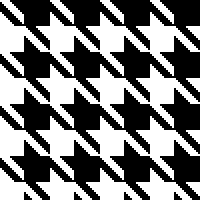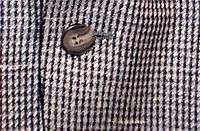Houndstooth
Houndstooth, hounds tooth check or hound's tooth (and similar spellings), also known as dogstooth, dogtooth, dog's tooth, or pied-de-poule, is a duotone textile pattern characterized by broken checks or abstract four-pointed shapes, often in black and white, although other colours are used. The classic houndstooth pattern is an example of a tessellation.
A smaller-scale version of the pattern can be referred to as puppytooth.[1][2]
Design and history
The oldest known occurrence of houndstooth is the Gerum Cloak[3], a garment uncovered in a Swedish peat bog, dated to between 360 and 100 BC.[4] Contemporary houndstooth checks may have originated in woven wool cloth of the Scottish Lowlands,[5] but are now used in many other materials. The traditional houndstooth check is made with alternating bands of four dark and four light threads in both warp and weft/filling woven in a simple 2:2 twill, two over/two under the warp, advancing one thread each pass. In an early reference to houndstooth, De Pinna, a New York City–based men's and women's high-end clothier founded in 1885, included houndstooth checks along with gun club checks and Scotch plaids as part of its 1933 spring men's suits collection.[6] Oversized houndstooth patterns were also employed prominently at Alexander McQueen's Fall 2009 Collection, entitled Horn of Plenty.[7] The patterns were a reference to Christian Dior's signature tweed suits.[8]
 Houndstooth pattern
Houndstooth pattern Weaving a small-scale houndstooth check in a 2:2 twill
Weaving a small-scale houndstooth check in a 2:2 twill Houndstooth cloth men's blazer by Lanvin.
Houndstooth cloth men's blazer by Lanvin.
Examples of use
The Australian department store David Jones uses a houndstooth pattern as part of its corporate logo. The branding—a black-on-white houndstooth pattern—is one of the most recognized corporate identities in Australia. A government-sponsored panel judged it in 2006 as one of Australia's top ten favorite trade marks.
Houndstooth designs of black and white, brown and tan, and other earthtone weaves, are very popular designs in tweed materials used for sport coats and other casual clothing. Houndstooth is a common design in casual hats and caps, perhaps most notable in the deerstalker, the kind of cap seen so often in illustrations and portrayals of Sherlock Holmes. U.S. college football coaching legend Paul "Bear" Bryant was frequently seen wearing a houndstooth or checkered patterned hat and houndstooth is frequently seen worn around the University of Alabama, where he coached, as a symbol of school pride.
The character Ricky (Portrayed by Robb Wells), from the Canadian television show Trailer Park Boys, is most often associated with his collared houndstooth shirt.
Artipoppe babywearing fashion house has also brought this design to their limited edition woven wraps under the name "Tweed" in various colors and exotic blends.
Houndstooth check trousers are occasionally worn with morning dress as a slightly less formal alternative to cashmere stripe trousers.
See also
- Checkerboard
- Greg's sheets
References
- ↑ The Independent, Nov 2 2009, Frankel, Susannah. "Ready to Wear: Houndstooth is fierce, and signifies power over and above prettiness". London.
- ↑ Charles Tyrwhitt, London webpage on Dogtooth
- ↑ http://historiska.se/upptack-historien/artikel/farganalys/
- ↑ http://historiska.se/upptack-historien/artikel/gerumsmanteln/
- ↑ Dunbar, John Telfer: The Costume of Scotland, London: Batsford, 1984, ISBN 0-7134-2534-2, 1984 (paperback 1989, ISBN 0-7134-2535-0)
- ↑ "Gun Club Checks". The New Yorker. New Yorker Magazine, Inc. 9: 28. 1933. OCLC 1760231. Retrieved October 9, 2011.
- ↑ Eric Wilson (11 March 2009). "McQueen Leaves Fashion in Ruins". New York Times. Retrieved 2 November 2015.
- ↑ Sarah Mower (10 March 2009). "Fall 2009 Ready-to-Wear Alexander McQueen". Vogue. Retrieved 2 November 2015.
The clothes were, for the most part, high-drama satires of twentieth-century landmark fashion: parodies of Christian Dior houndstooth New Look and Chanel tweed suits [...]
External links
| Wikimedia Commons has media related to Houndstooth. |


.svg.png)